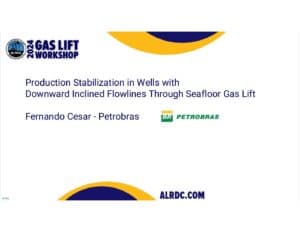Production Stabilization In Wells With Downward Inclined Flowlines Through Seafloor Gas Lift
Presentation:
Subsea bathymetry may play an important role in production flow stability. This is the case of a well located 14 km away from the production unit, demanding a long downward tie-back. Given such conditions, it was necessary to apply a solution to mitigate slugging problems.
The first approach was to evaluate if the gas injection through a gas lift valve inside the well column was able to stabilize the well production. Since this solution was not effective for a large interval along the well´s productive time, it was decided to investigate a solution applying gas lift injection at the riser base. This was done through simulations performed in a transient multiphase flow simulator, using a gas source to represent both the gas injection from the point in the flowline and from inside of the column. A second analysis was performed to determine the benefits of using a Venturi valve instead of an orifice valve for lift gas seafloor injection. The injection line was modeled, with the lift gas supplied from a pressure node in the production unit. Thus, the gas flow could be calculated in the injection line, using the compressor maximum pressure limit as a boundary condition, and the transient effects of the gas injection
could be analyzed.
The results showed that the riser base gas lift injection was able to stabilize the well flow with a lower lift gas in conditions when downhole injection could not. In addition, the studies showed it would be possible to produce the well along the whole project lifetime, while this was not feasible when using downhole gas lift when the water cut was higher than 65%. Comparing the differences between the gas injection through a Venturi valve and an orifice valve, the former manages to reach critical flow with a lower lift gas flowrate than the later one. The lift gas flowrate that was able to stabilize the well using the Venturi valve was not sufficient to provide critical flow in the orifice valve. Thus, in this case, lift gas flow rate in the injection line was still fluctuating
slightly, preventing production from stabilize. The gas injection flowrates required for well stabilization using an orifice valve were around 30% higher than those needed when using a Venturi valve.
This paper is a case study that describes the benefits of using seafloor gas lift injection, stabilizing the well and increasing its total oil production when compared to the scenario using downhole gas lift. It will also discuss the advantages of using Venturi valves over orifice valves for purposes of well stabilization using seafloor gas lift.

